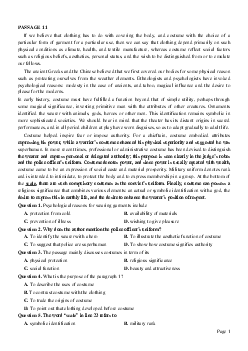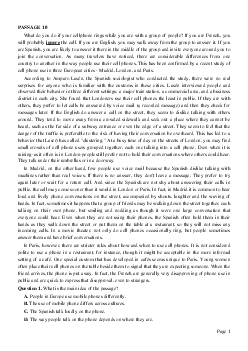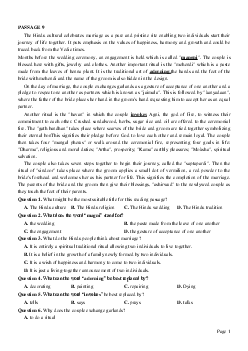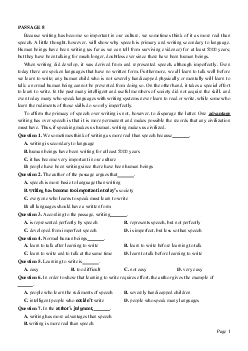



Preview text:
PASSAGE 29
The word “robot” first appeared in a 1921 stage play by Czech writer Karel Capek. In the play, a man
makes a machine that can think, which he calls a robot and which ends up killing its owner. In the 1940s,
the American science fiction writer Isaac Asimov wrote a series of stories about robots and invented the
term robotics, the science of robots. Meanwhile, in the real world, the first robots were developed by an
engineer, Joseph F. Engelberger, and an inventor, George C. Devol. Together they started Unimation, a
manufacturing company that produces the first real robot in 1961, called the Unimate. Robots of this type
were installed at a General Motors automobile plant and proved to be a success. They worked reliably
and saved money for General Motors, so other companies were soon acquiring robots as well.
These industrial robots were nothing like the terrifying creatures that can often be seen in science fiction
films. In fact, these robots looked and behaved nothing like humans. They were simply pieces of
computer-controlled machinery, with metal “arms” or “hands”. Since they were made of metal, they
could perform certain jobs that were difficult or dangerous for humans, particularly jobs that involve high
heat. And since robots were tireless and never got hungry, sleepy, or distracted, they were useful for tasks
that would be tiring or boring for humans. Industrial robots have been improved over the years, and today
they are used in many factories around the world. Though the use of robots has meant the loss of some
jobs, at the same time other jobs have been created in the design, development, and production of the robots.
Outside of industry, robots have also been developed and put to use by governments and scientists in
situations where humans might be in danger. For example, they can be sent in to investigate an
unexploded bomb or an accident at a nuclear power plant. In space exploration, robots have performed
many key tasks where humans could not be present, such as on the surface of Mars. In 2004, two robotic
Rovers-small six-wheeled computerized cars were sent to Mars.
Question 1. When did the word robot appear? A. before the 1920s B. in the early 1920s C. in the mid-1920s D. in the late 1920s
Question 2. Which of these statements is TRUE about Karel Capek?
A. He is a famous American playwight.
B. He was the first to create the word “robot”.
C. He invented a machine that can think like humans.
D. He made a robot kill a person.
Question 3. What does the word they in paragraph 2 refer to?
A. terrifying creatures B. humans
C. science fiction films D. industrial robots
Question 4. What are industrial robots like?
A. They are computer-controlled machines.
B. They are built with metal arms and legs.
C. They behave like humans.
D. They can think like humans.
Question 5. Which of the following is NOT mentioned as a characteristic of robots?
A. They never need food to survive.
B. They can survive without any sleep.
C. They are tired like humans.
D. They can do jobs involving intense heat.
Question 6. What can be inferred from the passage about robots? Page 1
A. Their appearance negatively affects the job market.
B. They can stop active volcanoes from erupting.
C. They help humans travel to the outer space.
D. They take away some jobs but offer some in return.
Question 7. Which of the following best paraphrases the sentence in bold in the first paragraph?
A. Because they were reliable and economical to General Motors, other companies started to use robots.
B. Other companies started to produce reliable and efficient robots for General Motors.
C. Every other company made use of robots because they were time-consuming and safe.
D. Robots worked well for General Motors, but caused certain trouble to others.
Question 8. What is the author’s attitude towards robots on this passage?
A. He appreciates them. B. He dislikes them.
C. He thinks they are a nuisance
D. He is crazy about them. ĐÁP ÁN 1-A 2-B 3-D 4-A 5-C 6-D 7-A 8-A
LỜI GIẢI CHI TIẾT Question 1:
Từ robot xuất hiện khi nào? A. trước những năm 1920
B. vào đầu những năm 1920
C. vào giữa những năm 1920
D. vào cuối những năm 1920
=> Dẫn chứng: The word “robot” first appeared in a 1921 stage play by Czech writer Karel Capek
Dịch: Từ Robot xuất hiện lần đầu tiên trong một vở kịch năm 1921 của nhà văn người Séc Karel Capek Question 2:
Phát biểu nào sau đây là ĐÚNG về Karel Capek?
A. Ông là một nhà viết kịch nổi tiếng người Mỹ.
B. Ông là người đầu tiên tạo ra từ robot Robot.
C. Ông đã phát minh ra một cỗ máy có thể suy nghĩ như con người.
D. Anh ta làm robot giết một người.
=> Dẫn chứng: The word “robot” first appeared in a 1921 stage play by Czech writer Karel Capek
Dịch: Từ Robot xuất hiện lần đầu tiên trong một vở kịch năm 1921 của nhà văn người Séc Karel Capek Question 3:
Từ họ trong đoạn 2 nói về điều gì? A. sinh vật đáng sợ B. con người
C. phim khoa học viễn tưởng D. robot công nghiệp Page 2
=> Dẫn chứng: These industrial robots were nothing like the terrifying creatures that can often be seen in
science fiction films. In fact, these robots looked and behaved nothing like humans. They were simply
pieces of computer-controlled machinery, with metal “arms” or “hands”.
DỊch: Những robot công nghiệp này không giống những sinh vật đáng sợ thường thấy trong các bộ phim
khoa học viễn tưởng. Trên thực tế, những robot này nhìn và cư xử không giống con người. Chúng chỉ đơn
giản là những mảnh máy móc được điều khiển bằng máy tính, với những cánh tay kim loại, hay tay cầm kim loại. Question 4:
Robot công nghiệp như thế nào?
A. Chúng là những máy được điều khiển bằng máy tính.
B. Chúng được chế tạo với cánh tay và chân kim loại.
C. Chúng cư xử như con người.
D. Họ có thể suy nghĩ như con người.
=> Dẫn chứng: They were simply pieces of computer-controlled machinery, with metal “arms” or “hands”.
Chúng chỉ đơn giản là những mảnh máy móc được điều khiển bằng máy tính, với những cánh tay kim
loại, hay tay cầm kim loại. Question 5:
Điều nào sau đây KHÔNG được đề cập như một đặc điểm của robot?
A. chúng không bao giờ cần thức ăn để tồn tại.
B. Chúng có thể sống mà không cần ngủ.
C. Chúng mệt mỏi như con người.
D. Chúng có thể làm những công việc liên quan đến nhiệt độ cao.
=> Dẫn chứng: And since robots were tireless and never got hungry, sleepy, or distracted, they were
useful for tasks that would be tiring or boring for humans.
Dịch: Và vì robot không mệt mỏi và không bao giờ bị đói, buồn ngủ hoặc mất tập trung, chúng rất hữu
ích cho các nhiệm vụ sẽ gây nhàm chán hoặc nhàm chán cho con người. Question 6:
Điều gì có thể được suy ra từ đoạn văn về robot?
A. Sự xuất hiện của chúng ảnh hưởng tiêu cực đến thị trường việc làm.
B. Chúng có thể ngăn chặn các núi lửa đang hoạt động phun trào.
C. Chúng giúp con người du hành ra ngoài vũ trụ.
D. Họ lấy đi một số công việc nhưng cung cấp một số lợi nhuận.
=> Dẫn chứng: Though the use of robots has meant the loss of some jobs, at the same time other jobs
have been created in the design, development, and production of the robots.
Thông qua việc sử dụng robot có nghĩa là mất một số công việc, nhưng đồng thời các công việc khác đã
được tạo ra trong việc thiết kế, phát triển và sản xuất robot. Question 7:
Điều nào sau đây diễn giải câu in đậm trong đoạn đầu tiên tốt nhất?
A. Vì họ đáng tin cậy và kinh tế đối với General Motors, các công ty khác bắt đầu sử dụng robot. Page 3
B. Các công ty khác bắt đầu sản xuất robot đáng tin cậy và hiệu quả cho General Motors.
C. Mọi công ty khác đều sử dụng robot vì chúng tốn thời gian và an toàn.
D. Robot làm việc tốt cho General Motors, nhưng gây ra một số rắc rối nhất định cho những người khác.
=> Dẫn chứng: Robots of this type were installed at a General Motors automobile plant and proved to be
a success. They worked reliably and saved money for General Motors, so other companies were
soon acquiring robots as well.
Dịch: loại robot này đã được lắp đặt tại một nhà máy ô tô của General Motors và được chứng minh là
thành công. Họ đã làm việc đáng tin cậy và tiết kiệm tiền cho General Motors, vì vậy các công ty khác cũng sớm mua lại robot. Question 8:
Thái độ của tác giả đối với robot trên đoạn văn này là gì?
A. Ông đánh giá cao chúng. B. Ông không thích chúng.
C. Anh ấy nghĩ rằng chúng là một mối phiền toái D. Anh ấy phát điên vì chúng.
=> Dẫn chứng: Outside of industry, robots have also been developed and put to use by governments and
scientists in situations where humans might be in danger. For example, they can be sent in to investigate
an unexploded bomb or an accident at a nuclear power plant. In space exploration, robots have performed
many key tasks where humans could not be present, such as on the surface of Mars. In 2004, two robotic
Rovers-small six-wheeled computerized cars were sent to Mars.
Dịch: Ngoài ngành công nghiệp, robot cũng đã được chính phủ và các nhà khoa học phát triển và sử dụng
trong các tình huống mà con người có thể gặp nguy hiểm. Ví dụ, họ có thể được gửi đến để điều tra một
quả bom chưa nổ hoặc một vụ tai nạn tại nhà máy điện hạt nhân. Trong thám hiểm không gian, robot đã
thực hiện nhiều nhiệm vụ chính mà con người không thể có mặt, chẳng hạn như trên bề mặt Sao Hỏa.
Vào năm 2004, hai chiếc Rovers robot - những chiếc ô tô máy vi tính sáu bánh nhỏ đã được gửi tới Sao Hỏa. Page 4




